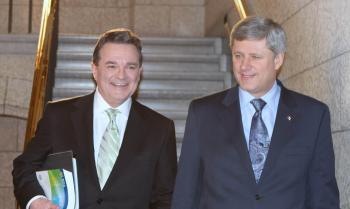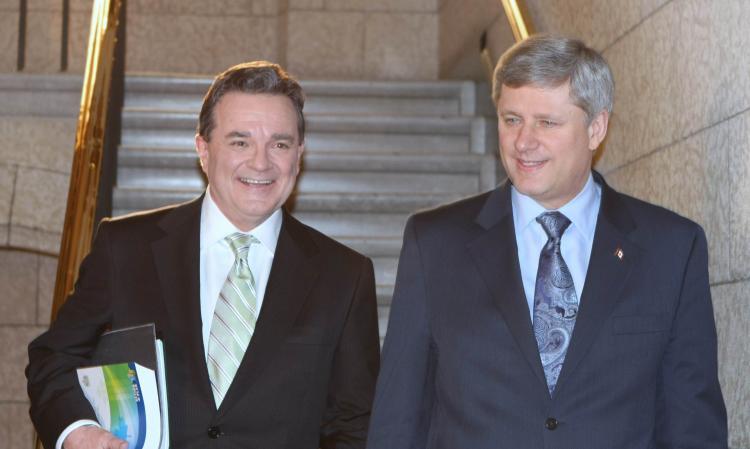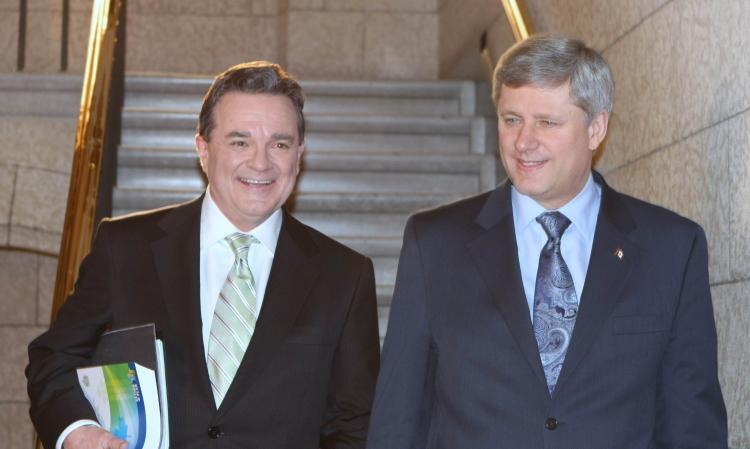OTTAWA—Canada’s federal budget for 2010 confirms $19 billion of new funding for year two of the Conservatives’ stimulus plan along with a host of new and continuing economic and job-growth initiatives.
Facing a rising fiscal deficit, the government also outlined spending cuts to return to near-balanced books by 2015, including measures to save $17.6 billion over the next five years that will impact foreign aid and the military.
“We present today a jobs and growth budget,” said Finance Minister Jim Flaherty in delivering the budget Thursday afternoon.
“In this budget, we are completing our Economic Action Plan to create jobs now. We are taking additional measures to protect existing jobs and create new jobs. We are also looking ahead to secure our long-term economic growth.”
Of the $62 billion total stimulus committed under the action plan last year, most of the first $37 billion have already flowed into the economy.
This year, partnerships with the provinces, territories, and municipalities will add $6 billion to the $19 billion federal funding, bringing the total infrastructure stimulus to $25 billion, said Industry Minister Tony Clement at a news conference following Mr. Flaherty’s budget speech.
The stimulus money will end on March 31, 2011. However, the federal gas tax rebate program will become permanent, a move applauded by the Federation of Canadian Municipalities (FCM). The rebates provide $2 billion annually in gas tax revenues to municipalities for transportation infrastructure.
Along with funding for affordable housing and the GST Rebate for municipalities, “these investments will help local governments—and Canadian property tax payers—build the infrastructure that is the backbone of our economy and quality of life,” said Basil Stewart, FCM president and mayor of Summerside, P.E.I., in a news release.
The Building Canada Fund, another program that began pre-recession, will also continue as part of ongoing federal contribution to municipal and provincial infrastructure, said Mr. Clement.
This year’s $19 billion of new federal money include $3.2 billion in personal income tax relief. Taxpayers will be able to earn more before paying federal tax and before crossing over to higher tax rates.
The budget sets aside $7.7 billion for infrastructure and housing stimulus, and $2.2 billion to support industries and communities most battered by the recession such as forestry, agriculture, tourism, and culture.
The government will also spend over $4 billion to help the 1.5 million unemployed through training opportunities and strengthened benefits including Employment Insurance benefits.
Another $1.9 billion will go toward post-secondary education, infrastructure, research, innovation, and environmental protection to create “the economy of tomorrow.”
The budget’s outlines additional initiatives to build jobs and growth.
There will be $108 million for internships and skills training to help youth find jobs, and over $100 million to extend work-sharing agreements.
“About 225,000 workers now have signed up through their employers for work-sharing. It’s been a very successful part of our program to ensure that if possible we can avoid permanent layoffs,” Mr. Clement said.
The government will invest over $600 million to boost innovation and its commercialization. Initiatives include post-doctoral fellowships to attract foreign talent, and increased budgets to college and university research programs and to granting councils emphasizing research in health, science, and engineering.
The budget also sets out measures to encourage business investment and trade. The government aims to make Canada tariff-free for industrial manufacturers, cut red tape for businesses, and support clean energy generation.
Canada will stay the course on corporate tax reductions. By 2012 the country’s corporate income tax rate will decline to 15 percent, the lowest in the G7.
And a major tax law change will mean foreign investors, most of whom are exempt from Canadian tax when they sell an investment, no longer have to file a Canadian tax return or wait for months for tax clearance to receive their money.
“This change puts Canada at the top of the list of places to invest globally,” according to Deloitte, a leading Canadian tax services company.
The budget contains no tax increases or cuts to transfer payments to Canadians and other levels of government, such as for healthcare, education, pensions, and equalization and the gas tax transfer to municipalities.
But another objective it has is to restore fiscal balance once the economy has recovered.
Restraint measures in five areas are expected to save $17.6 billion over five years. The government will stop further increases to foreign aid after the 8 percent increase announced for 2010-11. It also plans to slow down growth of the national defence budget, close tax loopholes, streamline government operations, and contain government administrative costs comprising mainly of salaries and benefits.
Containing administrative costs will alone generate $6.8 billion in savings.
Temporary stimulus measures will wind down as planned, such as the popular Home Renovation Tax Credit which expired Feb. 1.
And the government promises to review its functions and overhead to identify additional savings, with details to come in next year’s budget.
The budget also reduced the government’s projected deficit figures.
The earlier projection was for a $55.9 billion deficit for 2009-10 that would fall to $5.2 billion in 2014-15. The new projection is for a $53.8 billion deficit for 2009-10 that would drop to $27.6 billion in 2011-12, $17.5 billion in 2012-13, and $1.8 billion in 2014-15.
However, Kevin Gaudet, federal director of the Canadian Taxpayers Federation, said this does not bode well for future generations of taxpayers and his organization would have liked to see the stimulus program scrapped.
“[The budget] is presenting five more years of deficit. That will be seven straight years of deficit,” he said, adding that “every dollar [of stimulus] is borrowed money. Future taxpayers will have to pay it off.”
Canada is a tax-competitive jurisdiction with a stable banking system—the world’s only major economy that has not had a bank failure—and in the last quarter of 2009 Canada’s economy grew by 5 percent, Mr. Clement noted.
“That’s great,” he said, “but we know we’re at risk, that things can turn on a dime and impact on world markets. We’re continuing to work hard and making sure our economy is a high-growth economy and a competitive economy.”
Facing a rising fiscal deficit, the government also outlined spending cuts to return to near-balanced books by 2015, including measures to save $17.6 billion over the next five years that will impact foreign aid and the military.
“We present today a jobs and growth budget,” said Finance Minister Jim Flaherty in delivering the budget Thursday afternoon.
“In this budget, we are completing our Economic Action Plan to create jobs now. We are taking additional measures to protect existing jobs and create new jobs. We are also looking ahead to secure our long-term economic growth.”
Of the $62 billion total stimulus committed under the action plan last year, most of the first $37 billion have already flowed into the economy.
This year, partnerships with the provinces, territories, and municipalities will add $6 billion to the $19 billion federal funding, bringing the total infrastructure stimulus to $25 billion, said Industry Minister Tony Clement at a news conference following Mr. Flaherty’s budget speech.
The stimulus money will end on March 31, 2011. However, the federal gas tax rebate program will become permanent, a move applauded by the Federation of Canadian Municipalities (FCM). The rebates provide $2 billion annually in gas tax revenues to municipalities for transportation infrastructure.
Along with funding for affordable housing and the GST Rebate for municipalities, “these investments will help local governments—and Canadian property tax payers—build the infrastructure that is the backbone of our economy and quality of life,” said Basil Stewart, FCM president and mayor of Summerside, P.E.I., in a news release.
The Building Canada Fund, another program that began pre-recession, will also continue as part of ongoing federal contribution to municipal and provincial infrastructure, said Mr. Clement.
Completing the Stimulus Plan
This year’s $19 billion of new federal money include $3.2 billion in personal income tax relief. Taxpayers will be able to earn more before paying federal tax and before crossing over to higher tax rates.
The budget sets aside $7.7 billion for infrastructure and housing stimulus, and $2.2 billion to support industries and communities most battered by the recession such as forestry, agriculture, tourism, and culture.
The government will also spend over $4 billion to help the 1.5 million unemployed through training opportunities and strengthened benefits including Employment Insurance benefits.
Another $1.9 billion will go toward post-secondary education, infrastructure, research, innovation, and environmental protection to create “the economy of tomorrow.”
Initiatives for Youth, Workers, Businesses, Innovation, Investment
The budget’s outlines additional initiatives to build jobs and growth.
There will be $108 million for internships and skills training to help youth find jobs, and over $100 million to extend work-sharing agreements.
“About 225,000 workers now have signed up through their employers for work-sharing. It’s been a very successful part of our program to ensure that if possible we can avoid permanent layoffs,” Mr. Clement said.
The government will invest over $600 million to boost innovation and its commercialization. Initiatives include post-doctoral fellowships to attract foreign talent, and increased budgets to college and university research programs and to granting councils emphasizing research in health, science, and engineering.
The budget also sets out measures to encourage business investment and trade. The government aims to make Canada tariff-free for industrial manufacturers, cut red tape for businesses, and support clean energy generation.
Canada will stay the course on corporate tax reductions. By 2012 the country’s corporate income tax rate will decline to 15 percent, the lowest in the G7.
And a major tax law change will mean foreign investors, most of whom are exempt from Canadian tax when they sell an investment, no longer have to file a Canadian tax return or wait for months for tax clearance to receive their money.
“This change puts Canada at the top of the list of places to invest globally,” according to Deloitte, a leading Canadian tax services company.
Spending Restraints
The budget contains no tax increases or cuts to transfer payments to Canadians and other levels of government, such as for healthcare, education, pensions, and equalization and the gas tax transfer to municipalities.
But another objective it has is to restore fiscal balance once the economy has recovered.
Restraint measures in five areas are expected to save $17.6 billion over five years. The government will stop further increases to foreign aid after the 8 percent increase announced for 2010-11. It also plans to slow down growth of the national defence budget, close tax loopholes, streamline government operations, and contain government administrative costs comprising mainly of salaries and benefits.
Containing administrative costs will alone generate $6.8 billion in savings.
Temporary stimulus measures will wind down as planned, such as the popular Home Renovation Tax Credit which expired Feb. 1.
And the government promises to review its functions and overhead to identify additional savings, with details to come in next year’s budget.
Deficit Down to $1.8 Billion by 2015
The budget also reduced the government’s projected deficit figures.
The earlier projection was for a $55.9 billion deficit for 2009-10 that would fall to $5.2 billion in 2014-15. The new projection is for a $53.8 billion deficit for 2009-10 that would drop to $27.6 billion in 2011-12, $17.5 billion in 2012-13, and $1.8 billion in 2014-15.
However, Kevin Gaudet, federal director of the Canadian Taxpayers Federation, said this does not bode well for future generations of taxpayers and his organization would have liked to see the stimulus program scrapped.
“[The budget] is presenting five more years of deficit. That will be seven straight years of deficit,” he said, adding that “every dollar [of stimulus] is borrowed money. Future taxpayers will have to pay it off.”
Canada is a tax-competitive jurisdiction with a stable banking system—the world’s only major economy that has not had a bank failure—and in the last quarter of 2009 Canada’s economy grew by 5 percent, Mr. Clement noted.
“That’s great,” he said, “but we know we’re at risk, that things can turn on a dime and impact on world markets. We’re continuing to work hard and making sure our economy is a high-growth economy and a competitive economy.”






